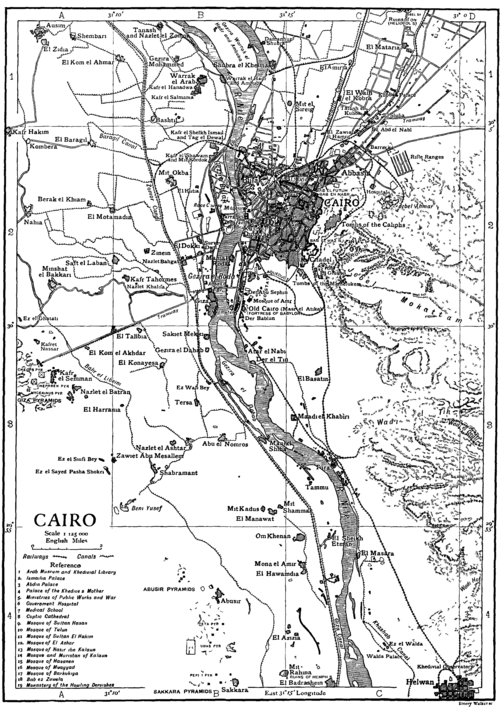Cairo, Misr-al-Kahira, or Misr. Part 3
Description
This section is from "The Encyclopaedia Britannica". Also available from Amazon: Great Books of the Western World (60 Volumes).
Cairo, Misr-al-Kahira, or Misr. Part 3
Tombs Of The Caliphs And Mamelukes
Beyond the eastern wall of the city are the splendid mausolea erroneously known to Europeans as the tombs of the caliphs; they really are tombs of the Circassian or Burji Mamelukes, a race extinguished by Mehemet Ali. Their lofty gilt domes and fanciful network or arabesque tracery are partly in ruins, and the mosques attached to them are also partly ruined. The chief tomb mosques are those of Sultan Barkuk, with two domes and two minarets, completed AD. 1410, and that of Kait Bey (c. 1470), with a slender minaret 135 ft. high. This mosque was carefully restored in 1898. South of the citadel is another group of tomb-mosques known as the tombs of the Mamelukes. They are architecturally of less interest than those of the "caliphs". Southwest of the Mameluke tombs is the much-venerated tomb-mosque of the Imam esh-Shafih or Shaf'i, founder of one of the four orthodox sects of Islam. Near the imam's mosque is a family burial-place built by Mehemet Ali.

Old Cairo: the Fortress of Babylon and the Nilometer. - About a mile south of the city is Masr-el-Atika, called by Europeans Old Cairo. Between Old Cairo and the newer city are large mounds of débris marking the site of Fostat (see below, History). The road to Old Cairo by the river leads past the monastery of the "Howling" Dervishes, and the head of the aqueduct which formerly supplied the citadel with water. Farther to the east is the mosque of Amr, a much-altered building dating from A.D. 643 and containing the tomb of the Arab conqueror of Egypt. Most important of the quarters of Masr-el-Atika is that of Kasr-esh-Shama (Castle of the Candle), built within the outer walls of the Roman fortress of Babylon. Several towers of this fortress remain, and in the south wall is a massive gateway, uncovered in 1901. In the quarter are five Coptic churches, a Greek convent and two churches, and a synagogue. The principal Coptic church is that of Abu Serga (St Sergius). The crypt dates from about the 6th century and is dedicated to Sitt Miriam (the Lady Mary), from a tradition that in the flight into Egypt the Virgin and Child rested at this spot.
The upper church is basilican in form, the nave being, as customary in Coptic churches, divided into three sections by wooden screens, which are adorned by carvings in ivory and wood. The wall above the high altar is faced with beautiful mosaics of marbles, blue glass and mother-of-pearl. Of the other churches in Kasr-esh-Shama the most noteworthy is that of El Adra (the Virgin), also called El Moallaka, or The Suspended, being built in one of the towers of the Roman gateway. It contains fine wooden and ivory screens. The pulpit is supported on fifteen columns, which rest on a slab of white marble. The patriarch of the Copts was formerly consecrated in this church. The other buildings in Old Cairo, or among the mounds of rubbish which adjoin it, include several fort-like ders or convents. One, south of the Kasr-esh-Shama, is called Der Bablun, thus preserving the name of the ancient fortress. In the Der Abu Sephin, to the north of Babylon, is a Coptic church of the 10th century, possessing magnificent carved screens, a pulpit with fine mosaics and a semi-circle of marble steps.
Opposite Old Cairo lies the island of Roda, where, according to Arab tradition, Pharaoh's daughter found Moses in the bulrushes. Two bridges, opened in 1908, connect Old Cairo with Roda, and a third bridge joins Roda to Giza on the west bank of the river. Roda Island contains a mosque built by Kait Bey, and at its southern extremity is the Nilometer, by which the Cairenes have for over a thousand years measured the rise of the river. It is a square well with an octagonal pillar marked in cubits in the centre.
Continue to:


